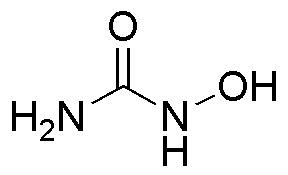Hydroxyurea is widely utilized in research focused on:
- Cancer Treatment: It is commonly used in chemotherapy regimens for certain types of cancer, particularly chronic myeloid leukemia and ovarian cancer, helping to slow down the growth of cancer cells.
- Sickle Cell Disease Management: Hydroxyurea is effective in increasing fetal hemoglobin levels, which can reduce the frequency of painful sickle cell crises and improve overall patient quality of life.
- Research on Genetic Disorders: It is used in studies investigating the genetic basis of diseases, as it can induce mutations in model organisms, aiding in the understanding of gene function and disease mechanisms.
- HIV Treatment: Hydroxyurea has been explored as an adjunct therapy in HIV treatment, as it may enhance the effectiveness of antiretroviral drugs by affecting viral replication.
- Dermatology Applications: In topical formulations, it is used to treat skin conditions like psoriasis and actinic keratosis due to its ability to promote cell turnover and reduce hyperkeratosis.
General Information
Properties
Safety and Regulations
Applications
Hydroxyurea is widely utilized in research focused on:
- Cancer Treatment: It is commonly used in chemotherapy regimens for certain types of cancer, particularly chronic myeloid leukemia and ovarian cancer, helping to slow down the growth of cancer cells.
- Sickle Cell Disease Management: Hydroxyurea is effective in increasing fetal hemoglobin levels, which can reduce the frequency of painful sickle cell crises and improve overall patient quality of life.
- Research on Genetic Disorders: It is used in studies investigating the genetic basis of diseases, as it can induce mutations in model organisms, aiding in the understanding of gene function and disease mechanisms.
- HIV Treatment: Hydroxyurea has been explored as an adjunct therapy in HIV treatment, as it may enhance the effectiveness of antiretroviral drugs by affecting viral replication.
- Dermatology Applications: In topical formulations, it is used to treat skin conditions like psoriasis and actinic keratosis due to its ability to promote cell turnover and reduce hyperkeratosis.
Documents
Safety Data Sheets (SDS)
The SDS provides comprehensive safety information on handling, storage, and disposal of the product.
Product Specification (PS)
The PS provides a comprehensive breakdown of the product’s properties, including chemical composition, physical state, purity, and storage requirements. It also details acceptable quality ranges and the product's intended applications.
Certificates of Analysis (COA)
Search for Certificates of Analysis (COA) by entering the products Lot Number. Lot and Batch Numbers can be found on a product’s label following the words ‘Lot’ or ‘Batch’.
*Catalog Number
*Lot Number
Certificates Of Origin (COO)
This COO confirms the country where the product was manufactured, and also details the materials and components used in it and whether it is derived from natural, synthetic, or other specific sources. This certificate may be required for customs, trade, and regulatory compliance.
*Catalog Number
*Lot Number
Safety Data Sheets (SDS)
The SDS provides comprehensive safety information on handling, storage, and disposal of the product.
DownloadProduct Specification (PS)
The PS provides a comprehensive breakdown of the product’s properties, including chemical composition, physical state, purity, and storage requirements. It also details acceptable quality ranges and the product's intended applications.
DownloadCertificates of Analysis (COA)
Search for Certificates of Analysis (COA) by entering the products Lot Number. Lot and Batch Numbers can be found on a product’s label following the words ‘Lot’ or ‘Batch’.
*Catalog Number
*Lot Number
Certificates Of Origin (COO)
This COO confirms the country where the product was manufactured, and also details the materials and components used in it and whether it is derived from natural, synthetic, or other specific sources. This certificate may be required for customs, trade, and regulatory compliance.


